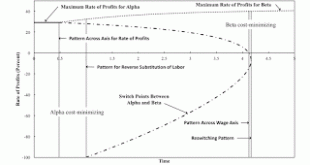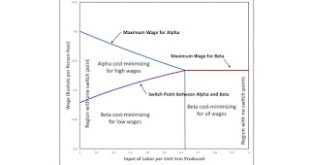[unable to retrieve full-text content]What I’m Reading Today: So, About The Gig Economy…: tl;dr: we waited 12 years for this????!!! (just kidding new data is always kind of fun)
Read More »What I’m Reading Today: So, About The Gig Economy…
[unable to retrieve full-text content]What I’m Reading Today: So, About The Gig Economy…: tl;dr: we waited 12 years for this????!!! (just kidding new data is always kind of fun)
Read More »Workers Benefiting From Increased Markups In Selected Industries
Figure 1: Variation in Switch Points with the Markup in the Iron Industry1.0 Introduction I finally use the tools of pattern analysis that I have been inventing to tell a practical story. I build on the example which I began in my previous post. Workers would be better off if an increase in wages led to greater employment, not less. A long-period change in relative markups among industries can result in firms in some industries obtaining a greater rate of profits at the expense of firms...
Read More »A Pattern For The Reverse Substitution Of Labor
Figure 1: Variation of Switch Points with Time1.0 Introduction This post presents another local pattern of co-dimension one. I have conjectured that only four types of local patterns of co-dimension one exist (a reswitching pattern, a three-technique pattern, a pattern across the wage axis, and a pattern over the axis for the rate of profits). In this conjecture, I meant to implicitly limit the rate of profits at which switch points occur to be non-negative and not exceeding the maximum...
Read More »Maybe It’s the “Job Creators” That Should Be More Grateful…
[unable to retrieve full-text content]Maybe It’s the “Job Creators” That Should Be More Grateful…: I guess the good news is that Trump was just doing what everyone else dows. The bad news is that Trump was just doing what everyone else does.
Read More »A Switch Point Disappearing Over The Wage Axis
Figure 1: Bifurcation Diagram1.0 Introduction In a series of posts, I have been exploring structural economic dynamics. Innovation reduces coefficients of production. Such reductions can vary the number and sequence of switch points on the wage frontier. I call such a variation a bifurcation. And I think such bifurcations, at least if only one coefficient decreases, fall into a small number of normal forms. One possibility is that a decrease in a coefficient of production results in a...
Read More »A Switch Point on the Wage Axis
Figure 1: Bifurcation Diagram1.0 Introduction I have been exploring the variation in the number and "perversity" of switch points in a model of prices of production. I conjecture that generic changes in the number of switch points with variations in model parameters can be classified into a few types of bifurcations. (This conjecture needs a more precise statement.) This post fills a lacuna in this conjecture. I give an example of a case that I have not previously illustrated. 2.0...
Read More » Heterodox
Heterodox




